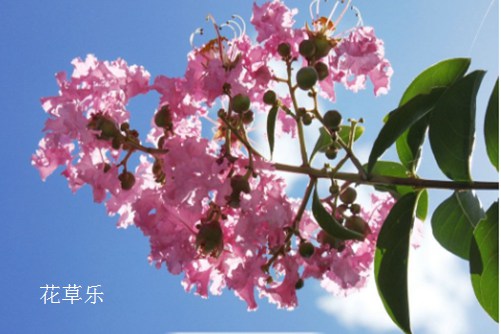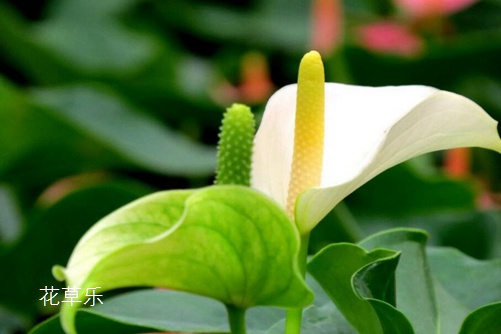What if the leaves of crape myrtle turn yellow? Causes and prevention of yellowing of leaves
Compared with other potted plants, crape myrtle is relatively easy to raise, its adaptability is quite strong, and the survival rate is also very high. However, have you noticed that some crape myrtle flowers are yellow and withered, which is due to improper nursing methods? Or is it the same lack of vitamins as people? Next, Huacao Le will introduce to you the reasons for this situation and the methods of prevention and control.
What if the leaves of crape myrtle turn yellow? Causes and prevention of yellowing of leaves

First, the reason why the leaves of crape myrtle turn yellow.
(1) the aging of life
Like people, crape myrtle will also experience birth, aging, sickness, death and natural metabolism. During this process, the leaves of the plant will gradually turn yellow and fall off due to the natural consumption of nutrients, which is a normal natural phenomenon in the growth of crape myrtle.
(2) lack of water or too much water
People have basic physiological needs such as eating, drinking and playing, and so do crape myrtle. When crape myrtle is short of water supply, the leaves of crape myrtle will slowly wither and yellow. Crape myrtle has strong drought resistance, when excess water will cause soil moisture to make it difficult for the roots to absorb sufficient oxygen and weaken or block, resulting in nutrients can not be transferred to the leaves, resulting in leaves withered and yellow.
(3) lack of fertilizer
Lack of nitrogen fertilizer: crape myrtle plants will be thin, branches will be slender and hard, leaves are small and flowers are small. The color of the leaves changed from thick green to light, red and purple, to yellow and shedding, and in severe cases, the whole plant did not have green.
Lack of phosphate fertilizer: the color of leaves changes from dark green to copper, and the petiole turns yellow and purplish. Flower buds are difficult to form, the number of flowers is small, the color is light, resulting in plant dysplasia, early withering and withering.
Lack of potash fertilizer: the plant is short and the stem is crooked and can not stand upright. The leaf is wrinkled, the old leaf appears dark brown spots along the leaf edge from the leaf tip, the leaf begins to turn yellow around the leaf, and the pulse of the middle and leaf is still green.
Lack of calcium fertilizer: young leaves wrinkle can not be opened, leaf edge roll up there are white stripes, new leaves are sickly twisted or can not be opened.
Lack of magnesium fertilizer: plant growth is not exuberant. The color of the old leaf from the bottom to the top, from the edge of the leaf to the center of the leaf, gradually faded green and turned white, and there were all kinds of spots on the vein, and finally all the leaf words turned yellow.
Lack of sulfur fertilizer: the tender leaves slowly yellowed from the veins of the leaves, until the leaves of the trees turned yellow, and the root system developed abnormally.
Iron deficiency fertilizer: all leaves slowly yellowed from the tender leaves.
2. prevention and control of yellowing of crape myrtle leaves.
(1) the aging of life
There is no need to worry about this situation, continue to do a good job of normal and reasonable maintenance and management of crape myrtle can safely through this natural behavior.
(2) lack of water or too much water
Adhering to the principle of "no dry, no watering", effective drainage measures must be taken in the rainy season to avoid the occurrence of rotting roots caused by stagnant water.
(3) lack of fertilizer
Lack of nitrogen fertilizer: supplement rotten human feces and urine, cake fertilizer, barnyard manure or ammonium sulfate, urea, ammonium nitrate and other fertilizers, must be mature fertilizer.
Lack of phosphate fertilizer: supplement bone meal, fish meal, chicken and cow manure or use calcium superphosphate, ammonium phosphate, potassium phosphate fertilizer, generally use about 0.10% aqueous solution as extra-root topdressing effect is very good.
Lack of potassium fertilizer: supplement the application of plant ash, 1% 2% potassium chloride aqueous solution (note that bulbs and root flowers cannot be used), 0.30% ~ 0.50% potassium nitrate aqueous solution as extra-root topdressing, or use inorganic fertilizers such as potassium phosphate.
Lack of calcium fertilizer: in the first half of sowing or potting, add an appropriate amount of calcium chloride to the soil, so that it can increase calcium and disinfect (note that acid-loving flowers can not be used), or it is good to use calcium nitrate as topdressing.
Magnesium deficiency fertilizer: spray 0.20% ~ 0.40% magnesium sulfate solution continuously for 3 to 4 times and recycle once at intervals of 7 to 10 days. Soils with severe magnesium deficiency need to use 5-10 kg of magnesium sulfate per mu, which is mixed with base fertilizer in autumn or winter.
Lack of sulfur fertilizer: spray with 0.30% ferrous sulfate solution for 3 times in a row, each time at an interval of 7 days. The fog point must be fine and uniform. At the same time, 0.20% urea hot metal solution can also be used for extra-root topdressing, and the effect is also very good.
Summary:
I believe you have a certain understanding of the reasons for the yellowing of leaves, please prescribe the right medicine to the case. May your family be full of flowers and rich flowers.
Time: 2019-04-23 Click:
- Prev

What if the leaves of an orchid turn yellow? Knowing these reasons can be solved completely.
The orchid is evergreen all the year round, dark green and bright, and the leaves are neatly shaped, tall and straight, elegant and elegant. At the same time, one-leaf orchid has strong adaptability and is very shade-tolerant, so it is an excellent indoor greening foliage plant. One-leaf orchid is warm and humid, very shady and cold-resistant. The suitable temperature for growth is 10-25 ℃.
- Next

How to raise the white palm, it can easily solve the yellowing of the leaves and keep the leaves green all the time.
White palm flowers tall and straight handsome, fresh and pleasing to the eye, with white flowers, giving people a fresh and natural feeling, favored by people, very suitable for potted decoration living room, study, reception room. But buying back home for a period of time will make the leaves yellow. in fact, there are many reasons why the leaves turn yellow.
Related
- Fuxing push coffee new agricultural production and marketing class: lack of small-scale processing plants
- Jujube rice field leisure farm deep ploughing Yilan for five years to create a space for organic food and play
- Nongyu Farm-A trial of organic papaya for brave women with advanced technology
- Four points for attention in the prevention and control of diseases and insect pests of edible fungi
- How to add nutrient solution to Edible Fungi
- Is there any good way to control edible fungus mites?
- Open Inoculation Technology of Edible Fungi
- Is there any clever way to use fertilizer for edible fungus in winter?
- What agents are used to kill the pathogens of edible fungi in the mushroom shed?
- Rapid drying of Edible Fungi

